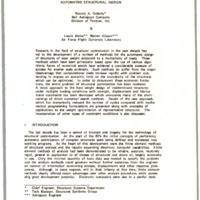The Use of Optimality Criteria in Automated Structural Design
Item
- Title
- The Use of Optimality Criteria in Automated Structural Design
- Description
- Research in the field of structural optimization in the past decade has led to the development of a number of methods for the automated design of structures of least weight subjected to a multiplicity of loads. These methods which have been principally based upon the use of various algorithmic forms of numerical search have achieved a considerable measure of success for smaller scale problems. Such methods do suffer from the major disadvantage that computational costs increase rapidly with problem size, tending to impose an economic limit on the complexity of the structures which can be optimized. In order to circumvent these economic limitations, the entire problem of structural optimization has been reviewed. A novel approach to the least weight design of indeterminate structures under multiple loading conditions with strength, displacement and fabricational constraints has been developed which overcomes many of the shortcomings of direct numerical search methods. Details of the new approach, which has dramatically reduced the number of cycles compared with mathematical programming formulations are presented along with examples of applications to the weight optimization of representative structures. The incorporation of other types of constraint conditions is also discussed.
- Creator
- Gellatly, Ronald A.
- Berke, Laszlo
- Gibson, Warren
- Abstract
- Research in the field of structural optimization in the past decade has led to the development of a number of methods for the automated design of structures of least weight subjected to a multiplicity of loads. These methods which have been principally based upon the use of various algorithmic forms of numerical search have achieved a considerable measure of success for smaller scale problems. Such methods do suffer from the major disadvantage that computational costs increase rapidly with problem size, tending to impose an economic limit on the complexity of the structures which can be optimized. In order to circumvent these economic limitations, the entire problem of structural optimization has been reviewed. A novel approach to the least weight design of indeterminate structures under multiple loading conditions with strength, displacement and fabricational constraints has been developed which overcomes many of the shortcomings of direct numerical search methods. Details of the new approach, which has dramatically reduced the number of cycles compared with mathematical programming formulations are presented along with examples of applications to the weight optimization of representative structures. The incorporation of other types of constraint conditions is also discussed.
- Corporate Author
- Bell Aerospace Company, Division of Textron, Inc.
- Air Force Flight Dynamics Laboratory
- Report Number
- AFFDL TR 71-160 p. 557-590
- Report Availability
- Full text available
- Publisher
- Wright-Patterson Air Force Base, OH : Air Force Flight Dynamics Laboratory, Air Force Systems Command and Air Force Institute of Technology, Air University
- Date
- 1973
- Type
- article
- Date Issued
- 1973-12
- Provenance
- Bombardier/Aero
- Distribution Classification
- 1
- Distribution Conflict
- No
- DTIC Record Exists
- No
- Format
- 1 online resource (34 pages) : ill.
- Extent
- 34
- Identifier
- AD0785968
Linked resources
Warning: Undefined array key "id_concat" in /var/www/html/omeka-s/themes/foundation/view/common/linked-resources.phtml on line 40
Warning: Undefined array key "property_alternate_label" in /var/www/html/omeka-s/themes/foundation/view/common/linked-resources.phtml on line 41
Warning: Undefined array key "property_label" in /var/www/html/omeka-s/themes/foundation/view/common/linked-resources.phtml on line 43
| Title | Class |
|---|---|
| Proceedings of the Third Conference on Matrix Methods in Structural Mechanics: Proceedings of the Conference held at Wright-Patterson Air Force Base, Ohio 19-21 October 1971 |
